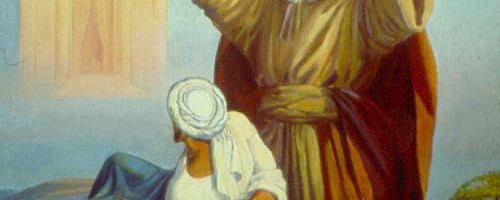Posted on Mar 26, 2015 |

Question submitted to “Ask the Rabbi” by: Name: Ary Kempler City: New York Full Question: “Did the Jews in their 40 years of wandering in the wilderness eat Matzo on Pessach? If so how did they get the wheat? Do you have a source for your answer? Thanks in advance!” Rabbi Tully Bryks responds: Once the Torah (Bible) was given at Mount Sinai, the Jews were already obligated to observe the 613 Mitzvos (commandments). There were some exceptions, and the Korban Pesach (Paschal offering) may have been one of those exceptions, as some commandments could only be observed in Israel or with a Temple or in a state of purity. But the rest of the laws of Pesach were still in effect, including the Mitzvah to eat Matzah. Regarding your question about wheat, the question can really be asked about food in general. How were 3 million people, limited to the technological achievements from over 3,000 years ago, able to feed themselves while wandering in the wilderness for 40 years? The answer is that G-d sustained us with “Man” (manna). G-d provided us with a miraculous daily food source that had the ability to taste like anything we wanted. So just as the Man could be eaten every Shabbos and fulfill our obligation to eat bread, I would suggest that the Man could also be used on Pesach to satisfy our obligation to eat Matzah. *Some suggested sources: Korban Pesach in the wilderness – See Tosafos and the Chiddushay Harim on the Talmud Kiddushin 37B and see Rashi on Shemos 12:25 Man – See Shemos 16:14 and the commentaries...
Read More »
Posted on Mar 23, 2015 |

Question submitted to “Ask the Rabbi” by: Name: Baila City: Columbia, Missouri Age: 17 School: Public school Full Question: “I heard that during pesach you can’t even touch chometz. I work at a grocery store as a cashier. I took off for the Yom tovs of course, but am I allowed to work on the days in between the Yom Tovs? All the food except fresh produce is always in packages.” Rabbi Tully Bryks responds: There are three potential issues working in a grocery store over Pesach (Passover): Handling bread products – You are correct that one is not allowed to even touch chametz (food containing bread) during Pesach, even if one does not own it. The concern is that a person may inadvertently eat it, since, unlike non-kosher food, chametz is food that we regularly eat the rest of the year. As long as you only handle the packages that contain the food and never touch the chametz itself, then you would avert this concern. Benefiting from Chametz – A potentially much more serious issue is the biblical prohibition of benefiting from chametz during Pesach. Feeding chametz to your pets, decorating your room with chametz, creating incense from chametz or selling chametz for profit, are just a handful of examples of “benefit”. So even though you are not the store owner, if the store was a bakery, then the wages you earn would be ultimately be considered a benefit from chametz. However, as long at the majority of products being sold in the grocery store are not chametz, then we can assume that your wages came from the profit of the non-chametz products that were sold. Work during Chol HaMoed – It is best not to work at any time during Pesach, even when it is not Yom Tov, as the days of Chol HaMoed (intermediary days) are still considered holy. If one needs to work during Chol HaMoed in order to support oneself, or if one would lose their job if they did not work, then it would be permitted. But even in such a case, one should study the laws of Chol HaMoed ahead of time so that you would know how to deal with melachos (creative activity), such as writing, which may need to be done with a shinui (in an unusual way). Bottom line – While it is better not to work at all during Pesach if possible, it is still permitted. In such a case, even working in a grocery store would be permitted, provided that the majority of products being sold are not actual chametz and that you try to avoid handing the chametz directly. Wishing you and your family a Chag Kasher v’Sameach (Kosher and Happy...
Read More »
Posted on Mar 22, 2015 |

Question submitted to “Ask the Rabbi” by: Name: Joanne City: Hemel Hempstead, England Full Question: “All the way through the Old Testament, the Jews are awaiting the arrival of a Messiah. Then Jesus arrives, performs miracles, etc. and many Jews follow him. Why did the rabbis not accept Jesus as the one that they had been waiting for and advise their people to all follow him?” Rabbi Tully Bryks responds: You are correct that we have waited long and hard for the Mashiach (Messiah) to come. His coming is a basic tenant of Jewish faith! There are several reasons why we are still waiting and the vast majority of Jews never accepted Jesus as the Mashiach. Here are just a handful: The Torah (Bible) and the Navi (Prophets) describe many rules for how to evaluate a prophet. One of the key rules for the Mashiach (and any prophet) is that he may not change any law of the Torah. Even if he changes just one law, regardless of how many miracles he may have performed, we are not allowed to follow him/her. The prophesies describing the Mashiach state clearly that the Mashiach would bring the final redemption, including a utopian society with total peace for all people and even animals, whereby “Nation shall not lift up sword against nation, neither shall man learn war anymore” and “the lion will lie down with the lamb.” Unfortunately, the past two thousand years have been plagued by constant violence, war and even attempts at genocide. Aside from bringing about world peace, the Mashiach will also bring about the rebuilding of the Beis Hamikdah (Holy Temple). Yet, the 2nd Beis Hamikdash had not even been destroyed by the Romans until 35-40 years after they killed Jesus. So his arrival was a little too early to be considered the Mashiach. Along those lines, the prophets go on to say that the Mashiach will gather all of the Jews back to the land of Israel. It took around 1,900 years since the death of Jesus for the Jews to finally have a state again in Israel. And even today, the majority of Jews still do not live in Israel. The prophesies also state that when the Mashiach comes, “all of the nations will worship the one true G-d,” bringing unity to the world. However, not only do the nations still lack unity in their faith of G-d, there are thousands (perhaps millions) of people who believe in multiple G-d’s or no G-d at all! The prophesies further state that when the Mashiach comes, prophecy will return. Today, the only people claiming to be prophets are typically the ones found in insane asylums. The prophesies further state the Mashiach would be a direct descendant, on the father’s side, from Kind David. For those who believe that Jesus did not have a father, then this would be impossible....
Read More »
Posted on Mar 20, 2015 |

Question submitted to “Ask the Rabbi” by: Name: Lee City: Lafayette, LA Age: 57 Profession: Computers Full Question: “Is there an understanding of the calendar date that Abraham went with Isaac for the sacrifice of Isaac? I was wondering if it corresponded to the date of the Exodus from Egypt, but can find nothing in Scripture?” Rabbi Tully Bryks responds: Akeidas Yitzchak (the binding of Isaac) took place in the year 1676 BCE. The Exodus from Egypt and the subsequent National Revelation at mount Sinai took place over 300 years later in the year 1313 BCE. As you may know, Avraham (Abraham) faced 10 major Divinely ordained tests and he successfully passed them all. According to most authorities, the test of being commanded to sacrifice his own beloved son, was the most difficult of all of the tests. The test, however, is called “Akeidas Yitzchak.” Perhaps one explanation is that this test was a test of Yitzchak (Isaac) as well, as he was already 37 years old at the time. And according to the Medrash (insights from the Oral Torah), when Avraham was preparing to tie Yitchak to the alter, Yitzchak asked his father to make sure to secure the ropes tightly, as he did not want to inadvertently flinch and potentially blemish the...
Read More »
Posted on Mar 19, 2015 |

Question submitted to “Ask the Rabbi” by: Name: Baila City: Columbia, Missouri Age: 17 School: Public school Full Question: “During Purim, why do we have to hear each word of the Megillah twice? Also if one doesn’t understand Hebrew very well, why do they still have to hear each word of the Megillah twice?” Rabbi Tully Bryks responds: There are several explanations behind the double Megillah reading. I will provide one of the more straightforward answers, provided by the famed commentator Rashi (see Talmud Megillah 4A): Just as the Jews at that time called out to G-d both night and day to save them from potential extermination, we call out our thanksgiving both night an day, as personified by the Megillah. This explanation is consistent with one of the reasons that we don’t recite Hallel (Songs of Praise) on Purim, as the Megillah serves the function of Hallel. With regard to the Hebrew language question, it is permitted to hear the Megillah read in any language that you understand. But you would not fulfill your obligation if it was read in French and you only understand English. Hebrew is different. Even if you don’t understand a word of Hebrew, you still fulfill your obligation, as the Hebrew language has a unique power to it. As such, for someone who does not understand Hebrew, the ideal would be to hear the Megillah read in Hebrew, while following along to yourself with an English translation. In this way, you would obtain the unique spiritual benefits of hearing the words in Hebrew and still get to fully understand everything that was...
Read More »











Recent Comments